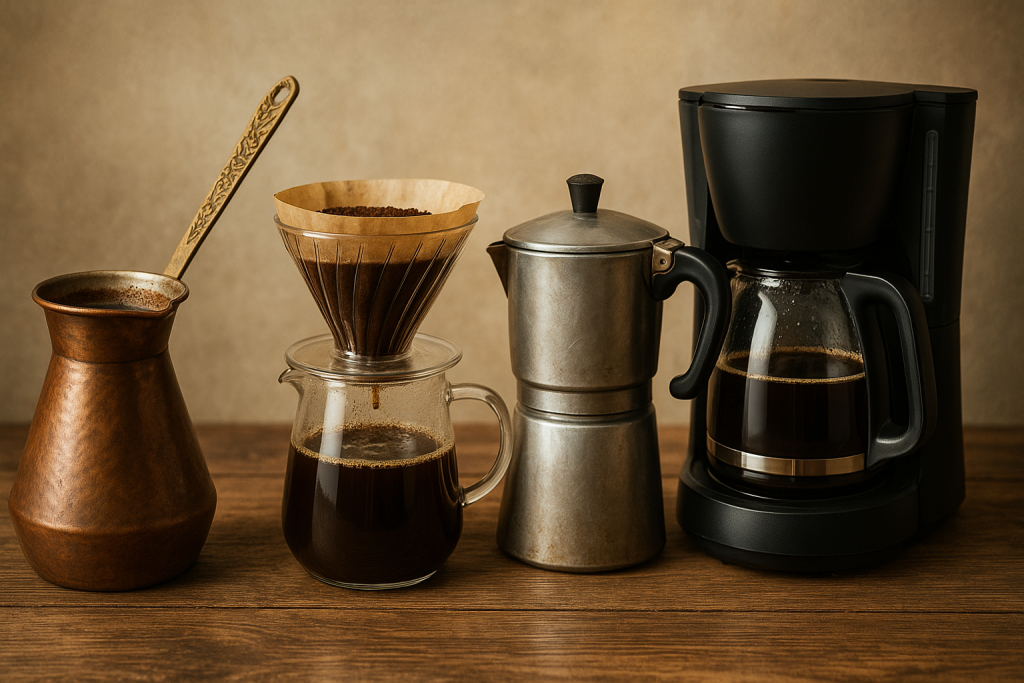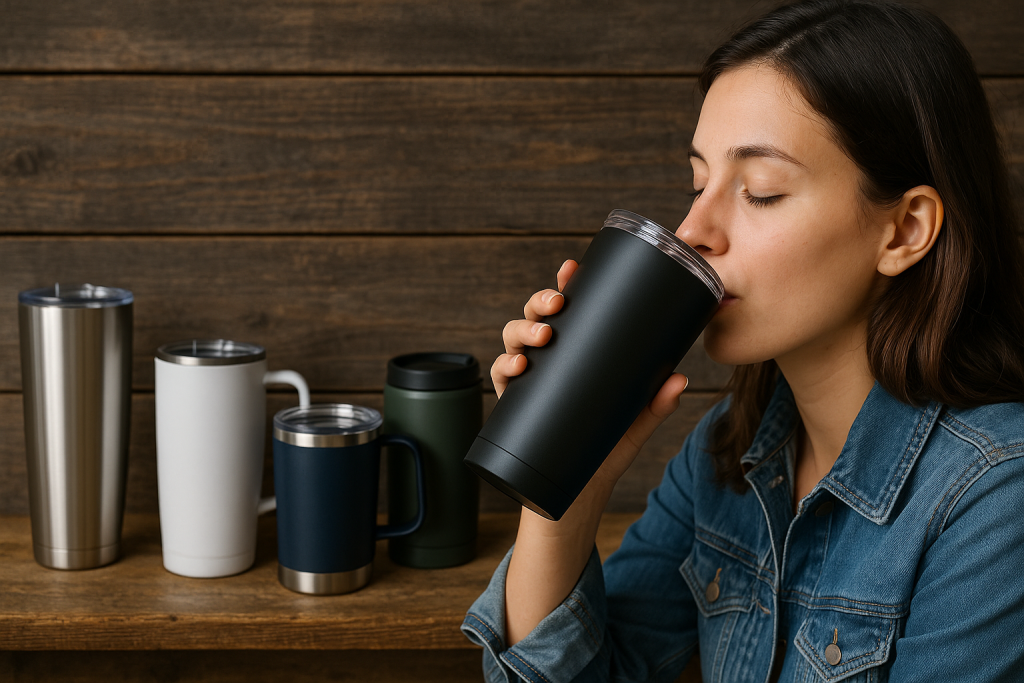
Intro
The art of making coffee has evolved significantly over centuries, transforming from rudimentary brewing techniques to the sophisticated machines we use today. Each method of coffee preparation has its own unique advantages, drawbacks, and impact on flavor. The quality of the water, the materials used in coffee machines, and even the type of filtration system can all influence the final cup. This article explores the history of coffee brewing, compares different methods, discusses potential health concerns with modern coffee makers, and identifies the best brewing technique for various preferences.
A Journey Through Time: The History of Coffee Brewing
Early Brewing Techniques
Before coffee was widely cultivated, early drinkers consumed coffee in its rawest form. The first known methods of brewing coffee date back over a thousand years.
- The Ethiopian Method (9th Century): Ethiopian tribes reportedly crushed coffee beans, mixed them with animal fat, and consumed them as an energy-rich food rather than a beverage. This method provided a slow release of caffeine, which was ideal for long journeys and physical labor.
- The Ottoman Turkish Method (15th Century): One of the earliest known methods of liquid coffee preparation involved finely ground coffee simmered in water with sugar and spices, creating a thick, sludgy drink known as Türk kahvesi. This method used a small metal pot called a cezve, which is still in use today. The result was a strong, unfiltered coffee with a layer of foam on top.
- Arabic and Middle Eastern Coffee (16th Century): Coffeehouses flourished in the Ottoman Empire, popularizing the brewing method of boiling coffee grounds in water, known today as qahwa. These coffeehouses became centers for discussion, poetry, and political discourse, much like modern cafés.
The Rise of Filtered and Infused Coffee (17th-19th Century)
As coffee spread to Europe, brewing techniques became more refined.
- French Press (1850s): A precursor to the modern French press was first introduced in France. The design evolved into a metal or glass carafe with a plunger that separates the grounds from the liquid, producing a rich, full-bodied coffee. This method retained the coffee’s natural oils, giving it a bold flavor and velvety mouthfeel.
- Drip Brewing (1908): German housewife Melitta Bentz invented the first paper coffee filter, revolutionizing how coffee was brewed by eliminating sediment. This invention allowed for cleaner coffee with less bitterness, as the filter removed excess oils and fines.
- Percolators (1800s-1950s): A staple in American households, percolators use continuous boiling to cycle water through coffee grounds, often resulting in over-extracted, bitter coffee. While nostalgic, this method fell out of favor as more precise brewing techniques emerged.
The Espresso Revolution (20th Century)
Espresso brewing was developed in Italy in the early 1900s, leading to the modern coffee culture we know today.
- First Espresso Machine (1901): Luigi Bezzera invented the first espresso machine, using steam pressure to speed up the brewing process. However, the early designs often produced coffee that was too hot and bitter.
- Pump-Driven Espresso Machine (1961): Ernesto Valente’s innovation of the Faema E61 introduced pump-driven machines, improving consistency and flavor. This invention laid the foundation for modern espresso technology, allowing for stable water pressure and temperature control.
- Home Espresso Machines (1970s-Present): The rise of consumer espresso machines allowed people to craft professional-quality espresso at home. These machines now come in various forms, from semi-automatic to fully automatic, catering to different skill levels.
Modern Coffee Brewing Methods: Pros, Cons, and Health Considerations
Today, coffee can be brewed using a variety of techniques, each with unique characteristics.
Drip Coffee Makers
- Pros: Easy to use, consistent results, and large batch capability.
- Cons: Can burn coffee if left on a warming plate too long, limited control over extraction.
- Health Concern: Many modern drip coffee makers contain plastic parts, which may leach chemicals like BPA when exposed to heat. Opt for stainless steel or glass carafes when possible.
French Press
- Pros: Retains natural coffee oils for full-bodied flavor, simple design with no need for disposable filters.
- Cons: Can leave sediment in the cup, requires more cleanup.
- Health Concern: Some research suggests unfiltered coffee (like French press) may raise LDL cholesterol due to the presence of cafestol.
Pour-Over (Chemex, Hario V60, Kalita Wave)
- Pros: Full control over brewing variables (temperature, bloom time, pour rate), results in a clean and flavorful cup.
- Cons: Requires more time and precision, not ideal for large batches.
- Health Concern: Generally safe, as it avoids plastic parts and uses paper filters to remove some cholesterol-raising compounds.
Espresso Machines
- Pros: Produces concentrated coffee with rich crema, forms the base for many specialty drinks.
- Cons: Expensive, requires skill and maintenance.
- Health Concern: High-pressure extraction avoids excessive leaching of materials, but lower-end machines may contain plastic components in the water reservoir.
Single-Serve Pod Machines (Keurig, Nespresso)
- Pros: Quick and convenient, minimal cleanup.
- Cons: Expensive per cup, environmental concerns with plastic waste.
- Health Concern: Some coffee pods contain plastic linings that can release chemicals when heated. Consider using compostable or stainless-steel refillable pods.
Cold Brew
- Pros: Naturally sweet, low acidity, can be stored for days.
- Cons: Long brewing time (12-24 hours), requires more coffee grounds.
- Health Concern: Cold brew avoids high temperatures, reducing the risk of chemical leaching.
The Importance of Water Quality in Coffee Brewing
Water is a crucial factor in coffee brewing, as it makes up about 98% of a cup of coffee. The mineral content, pH level, and purity of water can significantly affect the flavor of the brew.
Ideal Water Characteristics for Coffee Brewing
- Mineral Content: 150 ppm (parts per million) of total dissolved solids (TDS) for optimal extraction.
- pH Level: Slightly acidic to neutral (6.5-7.5).
- No Chlorine: Chlorinated water can impart off-flavors.
- No Hard Water: Excess minerals (calcium, magnesium) can cause scale buildup in coffee machines and affect flavor.
- Filtered Water: Using a charcoal filter or reverse osmosis system improves coffee flavor while preventing machine damage.
Choosing the Best Coffee Brewing Method for Your Needs
Each brewing method offers a unique experience, and the best choice depends on personal preference, budget, and lifestyle. By understanding the history, pros and cons, and health considerations of each technique, coffee lovers can make more informed decisions to enhance their daily cup.
Conclusion
The evolution of coffee brewing spans centuries, from simple boiling methods to sophisticated machines that offer precise control over extraction. While technology has improved convenience, traditional brewing methods remain cherished for their ability to highlight the intricate flavors of coffee. Regardless of the brewing method, using high-quality water and avoiding plastics in coffee makers can enhance the taste and health benefits of your brew. Whether you prefer the complexity of a pour-over, the robustness of espresso, or the smoothness of cold brew, the perfect cup of coffee is within reach.
Back to Coffee and Espresso 101






